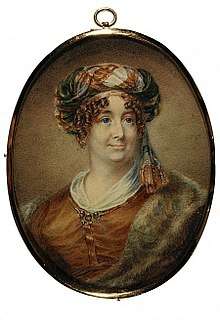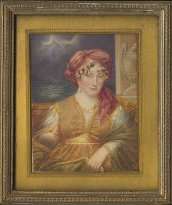Sarah Biffen
Sarah Biffen (October 1784 – 2 October 1850), also known as Biffin, Beffin,[1] or by her married name Mrs E.M. Wright,[2] was a Victorian English painter born with no arms. She was 94 cm (37 in) tall.

Life and work
Sarah Biffen was born in October 1784 to a family of farmers in East Quantoxhead, Somerset, with no arms and only vestigial legs. Despite her handicap, Biffen learned to read, and later was able to write using her mouth. She could also do needlework and use scissors.
When Biffen was twelve, her family apprenticed her to a man named Emmanuel Dukes, who exhibited her in fairs and sideshows throughout England.[3] According to some accounts, it was Dukes who taught her to paint, holding the paint-brush in her mouth, in order to increase her value as an attraction. In any case, during this period, she held exhibitions, sold her paintings and autographs, and took admission fees to let others see her sew, paint and draw. She drew landscapes or painted portrait miniatures on ivory, which she sold for three guineas each. Contemporaries praised her skill, and some of her miniatures survive to this day. Dukes apparently promised to give 1000 guineas if his protégée did not live up to his billing. However, Biffen may have received as little as £5 a year while she was with Dukes.[1]

In the St. Bartholomew's Fair of 1808, George Douglas, the Earl of Morton wanted to see if Biffen could really paint unaided. Once he was convinced, he sponsored her to receive lessons from a Royal Academy of Arts painter, William Craig.[3] The Society of Arts awarded her a medal in 1821 for a historical miniature and the Royal Academy accepted her paintings. The Royal Family commissioned her to paint miniature portraits of them, as a result of which she became very popular. She set up a studio in Bond Street, London. Charles Dickens mentioned her in Nicholas Nickleby, Martin Chuzzlewit, and Little Dorrit, and in "A Plated Article", when describing pottery figures spoiled in the firing process.
The Earl of Morton died in 1827. Without the support of a noble sponsor, Biffen ran into financial trouble when her manager used most of her money.[4] Queen Victoria awarded her a Civil List pension and she retired to a private life in Liverpool.[3] Some years later she married and 12 years later tried to renew her success with the name Mrs. Wright. The attempt was not successful but her supporters, including Richard Rathbone, arranged a public subscription to finance her for her final years.[1]
Sarah Biffen died on 2 October 1850 at the age of 66. She is buried in St James Cemetery in Liverpool.[5]
See also
- John Carter (mouth artist) (1815–1850), who was paralysed from below the neck after a fall.
- Bartram Hiles (1872–1927), a mouth artist who lost both arms in an accident.
References
- Stephen, Leslie, ed. (1886). "Biffin, Sarah". Dictionary of National Biography. 5. London: Smith, Elder & Co. p. 19.
- "Sarah Biffin, Mrs E.M. Wright, 1784 - 1850. Artist (Self-portrait)". www.nationalgalleries.org. The National Galleries of Scotland. Retrieved 28 November 2017.
- "Sarah Biffen (1784 - 1850)". Journey into art. Retrieved 17 March 2013.
- "Sarah Biffen — the limbless artisan". Human marvels. Archived from the original on 11 May 2013. Retrieved 17 March 2013.
- "Sarah Biffen". Checkmate Books. Retrieved 17 March 2013.
- London Life - Sara Biffen, The Limbless Wonder
- Clayton, Ellen Creathorne. English Female Artists, vol. 1] (Tinsley Brothers, 1876) pp. 395–7.
External links
- "Artworks of Sarah Biffin (British, 1784 - 1850)". www.mutualart.com. MutualArt Services, Inc.
- Sarah Biffin - self portrait (National Galleries of Scotland)
- Sarah Biffin – The Limbless Artisan ("The Human Marvels")
- Sarah Biffen (Checkmate Books)
- The amazing Sarah Biffen - artiste extraordinary ("Number One London" - blog)